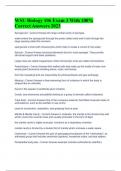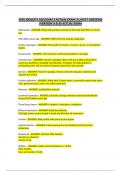Wsu biology 106 exam 3 - Study guides, Class notes & Summaries
Looking for the best study guides, study notes and summaries about Wsu biology 106 exam 3? On this page you'll find 33 study documents about Wsu biology 106 exam 3.
Page 2 out of 33 results
Sort by
WSU Biology 106 Exam 3 With 100% Correct Answers 2023
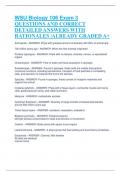
-
WSU Biology 106 Exam 3 QUESTIONS AND CORRECT DETAILED ANSWERS WITH RATIONALES |ALREADY GRADED A+
- Exam (elaborations) • 14 pages • 2023
- Available in package deal
-
- $13.99
- + learn more
WSU Biology 106 Exam 3 QUESTIONS AND CORRECT DETAILED ANSWERS WITH RATIONALES |ALREADY GRADED A+ Arthropods - ANSWER- Phyla with greatest amount of diversity with 85% of animal spp 700 million years ago - ANSWER- When the first animals originated Porifera (sponges) - ANSWER- Phyla with no tissues, muscles, nerves, or specialized organs Choanocytes - ANSWER- Flow of water and food acquisition in sponges Amoebocytes - ANSWER- Found in sponges, these cells are mobile and perform numer...
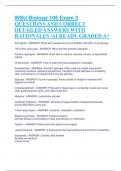
-
WSU Biology 106 Exam 3 QUESTIONS AND CORRECT DETAILED ANSWERS WITH RATIONALES |ALREADY GRADED A+
- Exam (elaborations) • 14 pages • 2023
-
- $12.99
- + learn more
WSU Biology 106 Exam 3 QUESTIONS AND CORRECT DETAILED ANSWERS WITH RATIONALES |ALREADY GRADED A+ Arthropods - ANSWER- Phyla with greatest amount of diversity with 85% of animal spp 700 million years ago - ANSWER- When the first animals originated Porifera (sponges) - ANSWER- Phyla with no tissues, muscles, nerves, or specialized organs Choanocytes - ANSWER- Flow of water and food acquisition in sponges Amoebocytes - ANSWER- Found in sponges, these cells are mobile and perform numer...
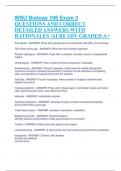
-
WSU Biology 106 Exam 3 QUESTIONS AND CORRECT DETAILED ANSWERS WITH RATIONALES |ALREADY GRADED A+
- Exam (elaborations) • 14 pages • 2023
- Available in package deal
-
- $13.99
- + learn more
WSU Biology 106 Exam 3 QUESTIONS AND CORRECT DETAILED ANSWERS WITH RATIONALES |ALREADY GRADED A+ Arthropods - ANSWER- Phyla with greatest amount of diversity with 85% of animal spp 700 million years ago - ANSWER- When the first animals originated Porifera (sponges) - ANSWER- Phyla with no tissues, muscles, nerves, or specialized organs Choanocytes - ANSWER- Flow of water and food acquisition in sponges Amoebocytes - ANSWER- Found in sponges, these cells are mobile and perform numer...
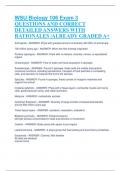
-
WSU Biology 106 Exam 3 QUESTIONS AND CORRECT DETAILED ANSWERS WITH RATIONALES |ALREADY GRADED A+
- Exam (elaborations) • 14 pages • 2024
- Available in package deal
-
- $12.99
- + learn more
WSU Biology 106 Exam 3 QUESTIONS AND CORRECT DETAILED ANSWERS WITH RATIONALES |ALREADY GRADED A+ Arthropods - ANSWER- Phyla with greatest amount of diversity with 85% of animal spp 700 million years ago - ANSWER- When the first animals originated Porifera (sponges) - ANSWER- Phyla with no tissues, muscles, nerves, or specialized organs Choanocytes - ANSWER- Flow of water and food acquisition in sponges Amoebocytes - ANSWER- Found in sponges, these cells are mobile and perform numer...
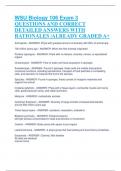
-
WSU Biology 106 Exam 3 QUESTIONS AND CORRECT DETAILED ANSWERS WITH RATIONALES |ALREADY GRADED A+
- Exam (elaborations) • 14 pages • 2023
- Available in package deal
-
- $11.99
- + learn more
WSU Biology 106 Exam 3 QUESTIONS AND CORRECT DETAILED ANSWERS WITH RATIONALES |ALREADY GRADED A+ Arthropods - ANSWER- Phyla with greatest amount of diversity with 85% of animal spp 700 million years ago - ANSWER- When the first animals originated Porifera (sponges) - ANSWER- Phyla with no tissues, muscles, nerves, or specialized organs Choanocytes - ANSWER- Flow of water and food acquisition in sponges Amoebocytes - ANSWER- Found in sponges, these cells are mobile and perform numer...
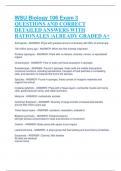
-
WSU Biology 106 Exam 3 QUESTIONS AND CORRECT DETAILED ANSWERS WITH RATIONALES |ALREADY GRADED A+
- Exam (elaborations) • 14 pages • 2023
-
Available in package deal
-
- $12.99
- + learn more
WSU Biology 106 Exam 3 QUESTIONS AND CORRECT DETAILED ANSWERS WITH RATIONALES |ALREADY GRADED A+ Arthropods - ANSWER- Phyla with greatest amount of diversity with 85% of animal spp 700 million years ago - ANSWER- When the first animals originated Porifera (sponges) - ANSWER- Phyla with no tissues, muscles, nerves, or specialized organs Choanocytes - ANSWER- Flow of water and food acquisition in sponges Amoebocytes - ANSWER- Found in sponges, these cells are mobile and perform nume...
WSU BIOLOGY 106 EXAM 3
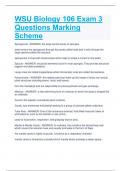
-
WSU Biology 106 Exam 3 Questions Marking Scheme
- Exam (elaborations) • 18 pages • 2024
- Available in package deal
-
- $11.99
- + learn more
WSU Biology 106 Exam 3 Questions Marking Scheme Spongocoel - ANSWER- the large central cavity of sponges. water enters the spongocoel through tiny pores called ostia and it exits through the large opening called the osculum. spongocoel is lined with choanocytes which help to create a current in the water. Spicule - ANSWER- structural elements found in most sponges. They provide structural support and deter predators. Large ones are called megascleres while microscopic ones are called mi...

-
WSU Biology 106 Exam 3 Questions Marking Scheme
- Exam (elaborations) • 18 pages • 2024
-
- $8.99
- + learn more
WSU Biology 106 Exam 3 Questions Marking Scheme Spongocoel - ANSWER- the large central cavity of sponges. water enters the spongocoel through tiny pores called ostia and it exits through the large opening called the osculum. spongocoel is lined with choanocytes which help to create a current in the water. Spicule - ANSWER- structural elements found in most sponges. They provide structural support and deter predators. Large ones are called megascleres while microscopic ones are called mi...

How did he do that? By selling his study resources on Stuvia. Try it yourself! Discover all about earning on Stuvia

